|
June 2000 Vol. 221 No. 6
Feature Article
|
SPECIAL REPORT: Southeast Asia Part 5
Conoco’s West Natuna project proceeds with creativity
While some Southeast Asian gas proposals languish in this high oil
price era, creative business moves and innovative technology are spurring development of large gas reserves
offshore Indonesia and construction of the region’s largest international gas supply system
Kurt S. Abraham, Managing/International Editor
 aving done
business in Indonesia for 31 years, Conoco is one of the country’s major offshore operators. Although the
firm holds an inactive block onshore Irian Jaya, all of Conoco’s expenditure and activity is focused in
the Natuna Sea. aving done
business in Indonesia for 31 years, Conoco is one of the country’s major offshore operators. Although the
firm holds an inactive block onshore Irian Jaya, all of Conoco’s expenditure and activity is focused in
the Natuna Sea.
Centerpiece of Conoco Indonesia Inc.’s (CII’s) current efforts is
the West Natuna Gas Transportation System, a major project to develop natural gas in the firm’s Block B
concession and transport the production 330 mi to Singapore, Fig. 1. The project involves development of a
series of small-to-medium-sized gas fields in Block B and construction of a pipeline route from there to
Singapore. To bring the project forward, CII has had to show some creativity, in terms of commerciality and
technology.
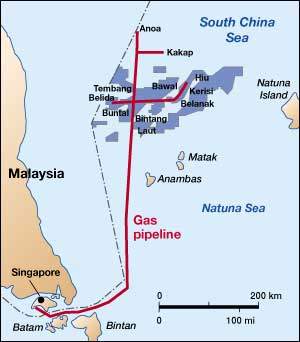 |
|
Fig. 1. The West Natuna Gas Transportation System project is
developing natural gas reserves in Conoco’s Block B concession and building a pipeline to
transport production about 330 mi to Singapore. |
|
Background
Successful negotiations by CII last year resulted in an agreement that will
lead to the first sale of pipelined gas from Indonesia to another country. The 22-year, West Natuna Sea sales
contract will provide Singapore with gas to be used primarily for generating electric power for industrial
purposes. The project will create the longest international natural gas supply and delivery system in the
Asia-Pacific region. It also is expected to stimulate gas demand in the region, as well as development of
proven gas reserves in the West Natuna Sea.
"The initial gas supply contract to Singapore is on a take-or-pay basis
at 325 MMcfgd," said Jim McColgin, CII’s president and general manager. "To secure this
contract, the commercial considerations required us to aggregate sufficient reserves to get a high-enough
production rate that would justify building a pipeline system. To do this, we formed the West Natuna Group,
consisting of the Conoco Block B partners, Premier Oil’s Block A partners and the Gulf Canada Kakap Block
partners."
Additionally, the project required finding a sufficient market to purchase the
gas, a task ably handled in Singapore by Sembgas. The ability to deliver on time also had to be assured. "The
commitment to deliver gas is July 2001, and we hope to have some gas in the system before then," said
McColgin. "The fact that Indonesia
is gas-prone helped to spur CII to put in the new pipeline. I think our mission here in the future
will be a mixture of oil and gas."
Pipeline Construction
The pipeline portion of the West Natuna project involves installing a 22-in.
gas pipeline from producing fields to the Belida / Belanak fields tie-in and then a 28-in. line from there to
Singapore.
Actual pipeline capacity without added compression is 750 MMcfgd. With
additional compression, it will be able to run 1 Bcfd. The pipeline contract was awarded to McDermott in May
1999. Dredging in the Singapore Straits began last September and finished in February 2000. All of the line
pipe has been manufactured, and most of it has been coated and is ready to be laid, Fig. 2.
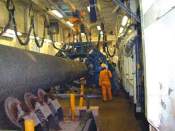 |
| |
Fig. 2. Manufacturing and coating of line pipe is mostly
complete, with laying of the line well underway. |
|
Welding and laying of the pipe began last January. Currently, McDermott’s
KP-1 barge is laying the 28-in. trunkline that runs from Singapore out to Block B, Fig. 3. The DB-26 barge is
in the field area, laying about 40 mi of smaller lateral lines that tie the three initial gas production
locations to the trunkline. As of late April, the KP-1 had laid about 300 km (186 mi) of the 472-km (293-mi)
trunkline.
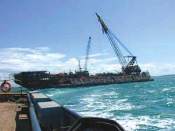 |
| |
Fig. 3. At press time, a pipelay barge had completed the
laying of about two-thirds of the 472-km trunkline. |
|
"The difficult portion of the pipeline is the crossing of the Singapore
Straits," said McColgin. "This is a very busy shipping fairway. The pipeline will be ‘armored’
across the Straits to protect it from ship anchors. About 2 million t of rock will be required for the
armoring. Additionally, it was necessary to dredge portions of the route, so that the pipeline would be deep
enough to not affect shipping."
Once it is laid, the pipeline will need to be hydrotested and dried. In
addition, the receiving terminal and control systems will have to be completed and tested prior to shipping
gas to end-users.
Development Scheme
CII’s gas supply responsibility for the West Natuna system is tied to
initial development of gas reserves in Block B. Plans call for output to be established at three fields –
Buntal, Tembang and Belida – during Phase 1 development, Fig. 4.
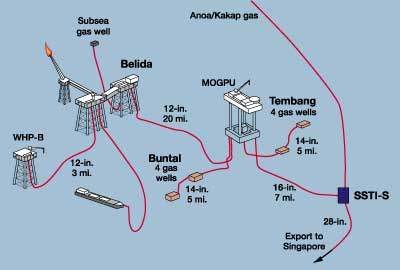 |
|
Fig. 4. CII’s contribution to the West Natuna system’s
gas supply will come initially from three fields (Belida, Buntal and Tembang) in Block B. |
|
The smaller size of fields in the western portion of the West Natuna area,
like Buntal and Tembang, has prompted CII to design and build a purpose-built, jackup, movable, offshore gas
production unit (MOGPU), Fig. 5. McColgin said this jackup will produce gas initially from Tembang and Buntal
fields. As output declines and peaks in different fields, the unit could conceivably move location two or
three more times in its 30-year life.
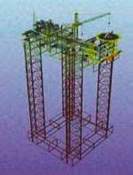 |
| |
Fig. 5. In support of the Singapore gas supply contract,
Conoco designed a Movable Offshore Gas Production Unit (MOGPU) for use in Block B of Indonesia’s
West Natuna Sea. Shown under construction, the unit can be relocated within the block as older
reserves are depleted. |
|
"We started fabrication of our MOGPU last February," said McColgin. "It
is being built by Hyundai Heavy Industries at their yard in Ulsan, South Korea. The unit is not scheduled to
go to the field until 2001, and, as it is in the early stages of construction, there is not a whole lot to see
just yet.
"Eventually, it will be shaped like a barge and look largely like a
production platform, with a 250-MMcfgd capacity," added McColgin. "It’s really a large dry-gas
vessel with walls on the sides, capable of floating to the next location."
Plans call for developing four gas wells at Buntal, as well as putting another
four wells onstream at Tembang. All eight wells will produce to the MOGPU. In addition, a subsea gas well will
be drilled and brought onstream at Belida. It will be tied back to the field’s central platform, Fig. 6.
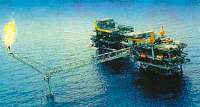 |
| |
Fig. 6. The central Belida platform will process output tied
back from a new subsea well. |
|
"We will begin development drilling for the project in the third quarter
of this year," said McColgin. "However, we have not started any of the wells at this time. We will
use the
Stena Clyde rig, which is the same unit that we used in Block B last year (Fig. 7). It is currently at
work on exploration and field delineation wells in Block B."
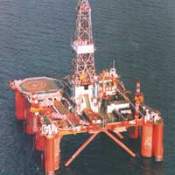 |
| |
Fig. 7. CII’s development drilling for the West Natuna
gas supply project will begin in third-quarter 2000 from this semisubmersible rig. |
|
In anticipation of growing demand, Conoco’s drilling campaign offshore
Indonesia was increased during 1999. This activity resulted in new discoveries that will allow the company to
double its Indonesian gas reserves. These new reserves, and the excess capacity being built into the pipeline
to Singapore, will improve Conoco’s ability to supply the region’s future demands for natural gas.

Acknowledgment
The author would like to thank CII President and General Manager Jim McColgin
and his staff for their assistance in providing further documentation and photos for this article.
|









